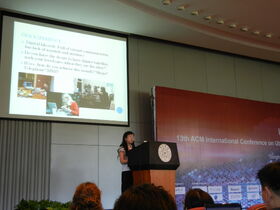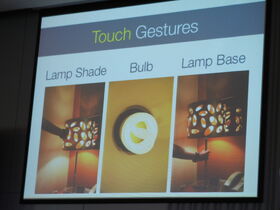
Event Name: 13th ACM International Conference on Ubiquitous Computing - UbiComp2011
Date: Sep 17-21, 2011
Venue: Tsinghua University, Beijing, China
Website: http://www.ubicomp.org/ubicomp2011/index.html
Introduction:
UbiComp is the premier outlet for novel research contributions that advance the state of the art in the design, development, deployment, evaluation and understanding of ubiquitous computing systems. Ubicomp is an interdisciplinary field of research and development that utilizes and integrates pervasive, wireless, embedded, wearable and/or mobile technologies to bridge the gaps between the digital and physical worlds. The UbiComp 2011 program features keynotes, technical paper sessions, specialized workshops, live demonstrations, posters, video presentations, panels, industrial exhibition and a Doctoral Colloquium.
There are 10 sessions in total, and many interesting papers, here I list some of them. The videos and talks are now available at http://www.slideshare.net/tag/ubicomp2011/3 .
Day 1:

Keynote Speaker:
Jan Chipchase, Executive Creative Director of Global Insights at frog.

Jun Rekimoto gave a presentation about their paper regarding smile device. They developed a device to recognize smile and embed it into various home appliance to encourage people smile more in their daily lives. For example, poeple need to smile to enter the room, smile to open the fridge door. They also carried out field study to test the functionality and accuracy. In the end, he proposed "Design Inconvinience", instead of decreasing user's activitity, they think it is better to increase the activity, "User has to do something".

As the 3rd paper in Session one, I presented our paper, the CoDine system, a dining table embedded with various interactive subsystems to augment and transport the communal experience of remote family dinner. After the presentation, people asked questions and gave us several valuable feedbacks. One of them mentioned the multi-points remote dining, instead of one to one communication. also, one lady asked about the elderly acceptance, and another person mentioned the time difference issue in different countries. It is really good to have people interested in our projects and gave us their suggestions.
There are also two interesting videos. The first is "FlyingBuddy: Augment Human Mobility and Perceptibility", they created a flying robot-like device for sensing, photographing, and interacting remotely.

During the lunch time, we had the poster session. We presented the CoDine and taste poster. Many people were interested in these two projects and came to ask questions. They thought the Co-dining and digital taste ideas were interesting and crazy, and some asked about the application of the digital taste. It seems to be very novel vision for them.

In the afternoon session, one paper called "Leveraging Conductive Inkjet Technology to Build a Scalable and Versatile Surface for Ubiquitous Sensing" is very interesting. They created a low-cost scalable and versatile distributed sensate surface based on a new conductive inkjet printing technology.
Another paper "HeatProbe: A Thermal-based Power Meter for Accounting Disaggregated Electricity Usage" uses heat detection for some sensing and recognition.
LightWave: Using Compact Fluorescent Lights as Sensors


Interactive 3D Modeling of Indoor Environments with a Consumer Depth Camera
They use the Kinect to construct the 3D mapping and introduced some application using this technology.



Benefits of Interactive 3D Mapping:
Robustness: Real-time feedback of mapping status and failures; Rewind/Recover/Resume; Delete frames; Remove false-positive loop closures; Propose additional loop closures
Completeness:
See the map as it is built and show the unexplored areas
Panel: John Seely Brown, Gregory Abowd, Paul Dourish, and Jun Rekimoto



Myngle: Unifying and Filtering Web Content For Unplanned Access Between Multiple Personal Devices
Design of Myngle:
Unified web history across personal devices
Fast access of content: Tag web pages with categories a user may want later; Filter web pages by high-level categories
PANDAA: Physical Arrangement Detection of Networked Devices through Ambient-Sound Awareness

